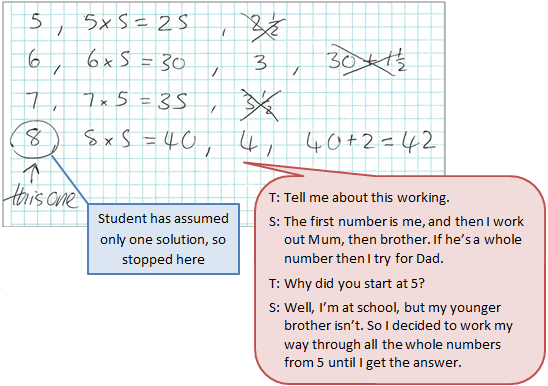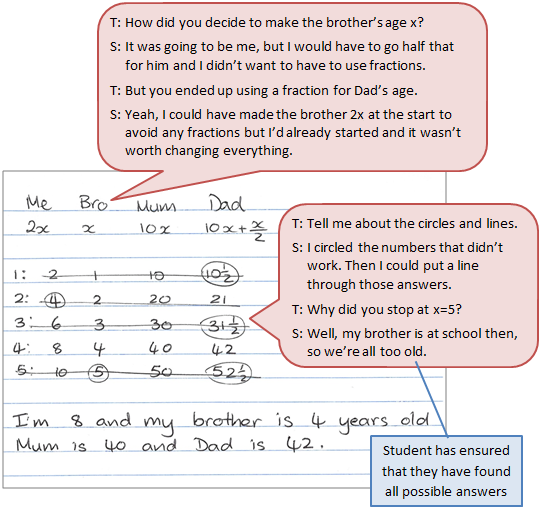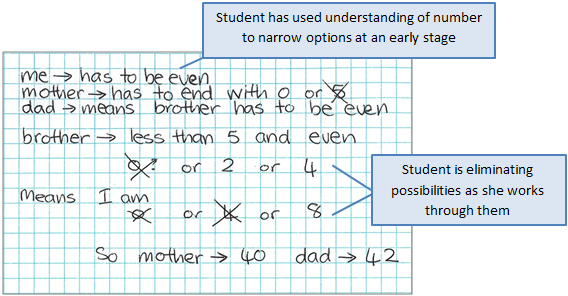How old!
The purpose of this activity is to engage students in solving a problem involving fractions.
This activity assumes the students have experience in the following areas:
- Finding multiples of a number and describing one number as a multiple of another.
- Describing one number as a fraction of another.
- Writing equations to solve word problems.
The problem is sufficiently open ended to allow the students freedom of choice in their approach. It may be scaffolded with guidance that leads to a solution, and/or the students might be given the opportunity to solve the problem independently.
The example responses at the end of the resource give an indication of the kind of response to expect from students who approach the problem in particular ways.

I am twice my brother's age and one fifth my mother's age.
My dad is older than mum by half my brother's age.
All our ages are whole numbers.
I go to school but my brother doesn't yet.
How old are we?
The following prompts illustrate how this activity can be structured around the phases of the Mathematics Investigation Cycle.
Make sense
Introduce the problem. Allow students time to read it and discuss in pairs or small groups.
- Do I understand the situation and the words? (Students may need support to understand that the ages are whole numbers of year, so ages like 1.5 years are not permitted.)
- What is the important information in the problem?
- Is any information that I need not there? What information is that?
- What will my solution look like? (The solution will the age for each person in the family that meets the conditions.)
- Is it possible that there might be more than one correct answer?
Plan approach
Discuss ideas about how to solve the problem. Emphasise that, in the planning phase, you want students to say how they would solve the problem, not to actually solve it.
- Do I know some ways to record and organise the information to make solving the problem easier?
- Could I draw a diagram to represent the ages?
- Could I write the clues as algebraic expressions, like a and 4a?
- Would a table help to organise my working with different ages?
- What are the maths skills I need to work this out?
- What might the solution be? What can’t the solution be? Why not?
- What tools (digital or physical) could help my investigation?
Take action
Allow students time to work through their strategy and find a solution to the problem.
- Whose age should I use to start with? Why should I use the age of that person?
- Have I recorded my ideas in a way that helps me to see patterns and helps me see that I have not missed a possible solution?
- Are there any patterns?
- How might I describe the pattern?
- How does the pattern help me to answer the question?
- Does my solution answer the question? How could I check?
- Is there another possible answer or way to solve it?
Convince yourself and others
Allow students time to check their answers and then either have them pair share with other groups or ask for volunteers to share their solution with the class.
- What is the solution? Does it match all the conditions?
- Can I be sure that I have not missed a solution?
- Is my working clear for someone else to follow?
- How would I convince someone else I am correct?
- Could I have solved the problem in a more efficient way? Which strategy might I use to solve a similar problem next time?
- Have I considered all possible cases (ages)?
Examples of work
Work sample 1
The student uses a systematic approach to eliminate ages that do not work, to find one solution.
Click on the image to enlarge it. Click again to close.
Work sample 2
The student forms and solve appropriate algebraic expressions, and uses a table of values to find the solution set for the problem.
Click on the image to enlarge it. Click again to close.
Work sample 3
The student finds the solution set to a problem, using the patterns and relationships described.


